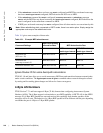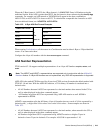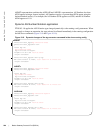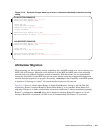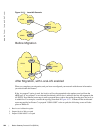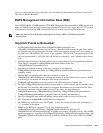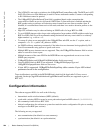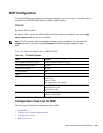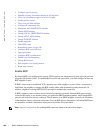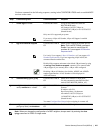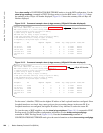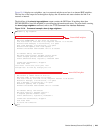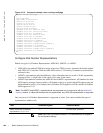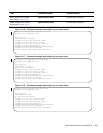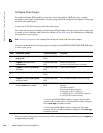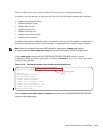
226 | Border Gateway Protocol IPv4 (BGPv4)
www.dell.com | support.dell.com
• Configure passive peering
• Maintain existing AS numbers during an AS migration
• Allow an AS number to appear in its own AS path
• Enable graceful restart
• Filter on an AS-Path attribute
• Configure IP community lists
• Manipulate the COMMUNITY attribute
• Change MED attribute
• Change LOCAL_PREFERENCE attribute
• Change NEXT_HOP attribute
• Change WEIGHT attribute
• Enable multipath
• Filter BGP routes
• Redistribute routes on page 246
• Configure BGP route reflectors
• Aggregate routes
• Configure BGP confederations
• Enable route flap dampening
• Change BGP timers
• BGP neighbor soft-reconfiguration
• Route map continue
Enable BGP
By default, BGP is not enabled on the system. FTOS supports one Autonomous System (AS) and you must
assign the AS Number (ASN). To establish BGP sessions and route traffic, you must configure at least one
BGP neighbor or peer.
In BGP, routers with an established TCP connection are called neighbors or peers. Once a connection is
established, the neighbors exchange full BGP routing tables with incremental updates afterwards. In
addition, neighbors exchange KEEPALIVE messages to maintain the connection.
In BGP, neighbor routers or peers can be classified as internal or external. External BGP peers must be
connected physically to one another (unless you enable the EBGP multihop feature), while internal BGP
peers do not need to be directly connected. The IP address of an EBGP neighbor is usually the IP address
of the interface directly connected to the router. First, the BGP process determines if all internal BGP peers
are reachable, and then it determines which peers outside the AS are reachable.
Note: Sample Configurations for enabling BGP routers are found at the end of this chapter.



